Organisation Behaviour & Culture Analysis
VerifiedAdded on 2021/01/02
|15
|4806
|438
AI Summary
Contribute Materials
Your contribution can guide someone’s learning journey. Share your
documents today.
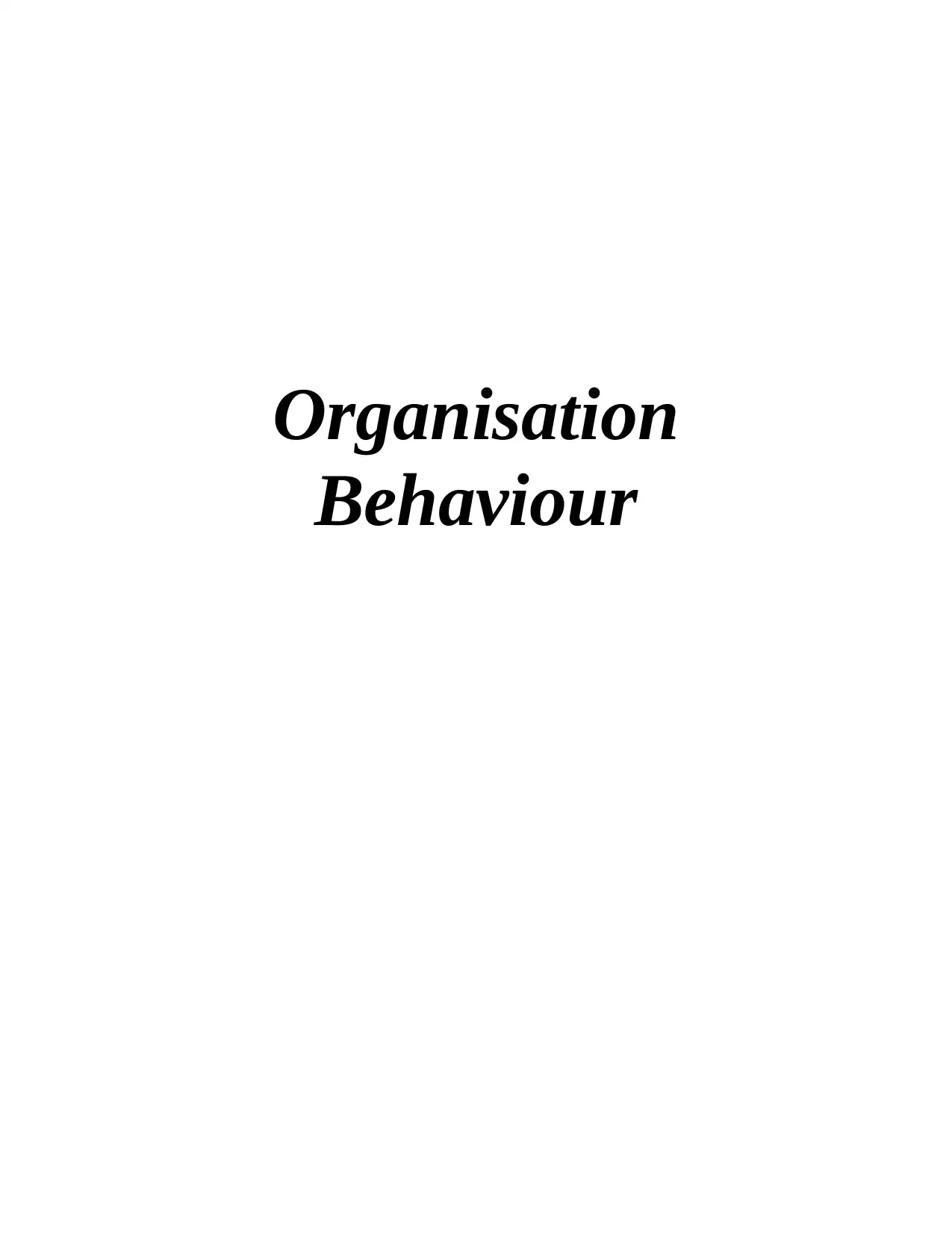
Organisation
Behaviour
Behaviour
Secure Best Marks with AI Grader
Need help grading? Try our AI Grader for instant feedback on your assignments.
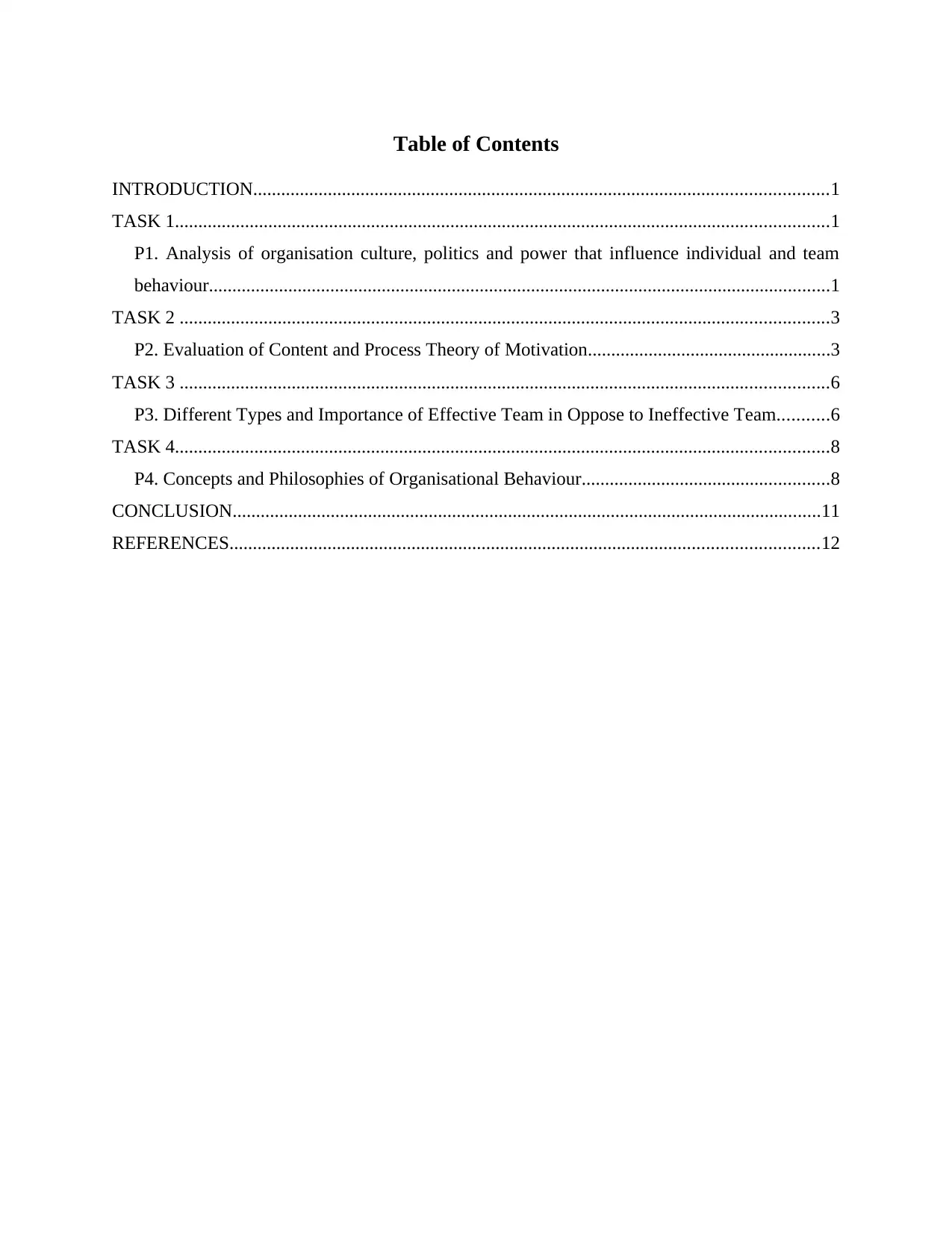
Table of Contents
INTRODUCTION...........................................................................................................................1
TASK 1............................................................................................................................................1
P1. Analysis of organisation culture, politics and power that influence individual and team
behaviour.....................................................................................................................................1
TASK 2 ...........................................................................................................................................3
P2. Evaluation of Content and Process Theory of Motivation....................................................3
TASK 3 ...........................................................................................................................................6
P3. Different Types and Importance of Effective Team in Oppose to Ineffective Team...........6
TASK 4............................................................................................................................................8
P4. Concepts and Philosophies of Organisational Behaviour.....................................................8
CONCLUSION..............................................................................................................................11
REFERENCES..............................................................................................................................12
INTRODUCTION...........................................................................................................................1
TASK 1............................................................................................................................................1
P1. Analysis of organisation culture, politics and power that influence individual and team
behaviour.....................................................................................................................................1
TASK 2 ...........................................................................................................................................3
P2. Evaluation of Content and Process Theory of Motivation....................................................3
TASK 3 ...........................................................................................................................................6
P3. Different Types and Importance of Effective Team in Oppose to Ineffective Team...........6
TASK 4............................................................................................................................................8
P4. Concepts and Philosophies of Organisational Behaviour.....................................................8
CONCLUSION..............................................................................................................................11
REFERENCES..............................................................................................................................12
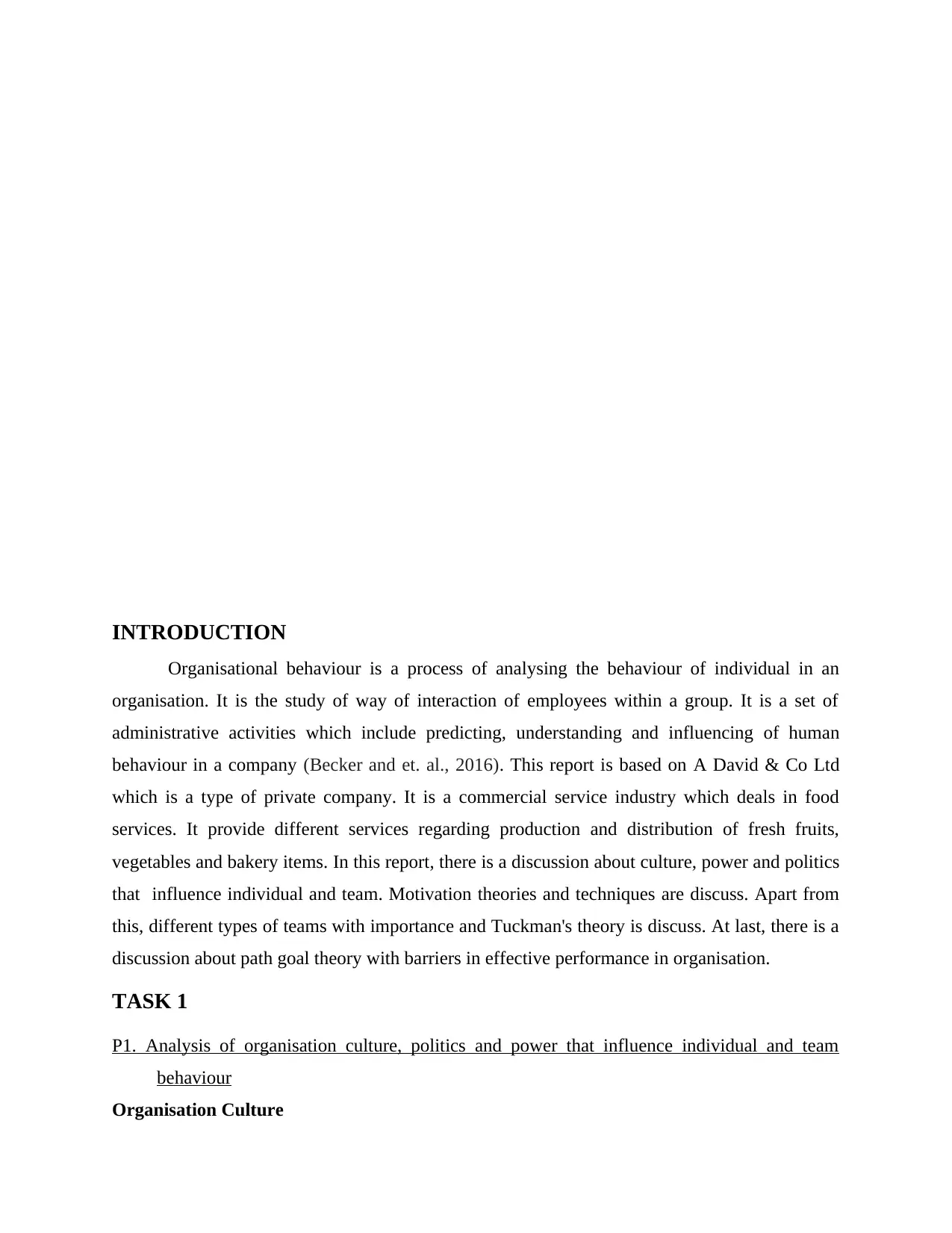
INTRODUCTION
Organisational behaviour is a process of analysing the behaviour of individual in an
organisation. It is the study of way of interaction of employees within a group. It is a set of
administrative activities which include predicting, understanding and influencing of human
behaviour in a company (Becker and et. al., 2016). This report is based on A David & Co Ltd
which is a type of private company. It is a commercial service industry which deals in food
services. It provide different services regarding production and distribution of fresh fruits,
vegetables and bakery items. In this report, there is a discussion about culture, power and politics
that influence individual and team. Motivation theories and techniques are discuss. Apart from
this, different types of teams with importance and Tuckman's theory is discuss. At last, there is a
discussion about path goal theory with barriers in effective performance in organisation.
TASK 1
P1. Analysis of organisation culture, politics and power that influence individual and team
behaviour
Organisation Culture
Organisational behaviour is a process of analysing the behaviour of individual in an
organisation. It is the study of way of interaction of employees within a group. It is a set of
administrative activities which include predicting, understanding and influencing of human
behaviour in a company (Becker and et. al., 2016). This report is based on A David & Co Ltd
which is a type of private company. It is a commercial service industry which deals in food
services. It provide different services regarding production and distribution of fresh fruits,
vegetables and bakery items. In this report, there is a discussion about culture, power and politics
that influence individual and team. Motivation theories and techniques are discuss. Apart from
this, different types of teams with importance and Tuckman's theory is discuss. At last, there is a
discussion about path goal theory with barriers in effective performance in organisation.
TASK 1
P1. Analysis of organisation culture, politics and power that influence individual and team
behaviour
Organisation Culture

Culture of an organisation is an amalgamation of beliefs, perception, ideologies and
values. Organizational culture helps the employees to motivate them and increases their
efficiency while working. This type of culture increases the competition between the employees
thus increasing the overall productivity of the A David & Co limited. With the help of Handy's
typology organizational culture will be discussed below,
There are four types of culture which an organization follows,
Power culture: In this culture, power remains in the hands of few individual or leaders.
They take the decision according to their judgement and knowledge. For instance A David & co
limited can use these type of culture in critical situation where fast decision should be taken by
the management to resolve the issue.
Task culture: Teams are divided into this type of culture to achieve a common goals of
the team. Groups are made according to their skills and abilities so that task could be achieved
within the deadline. This type of culture motivates the employees and increase their productivity
to a certain level (Belschak, Den Hartog and Kalshoven, 2015). A David & co limited can use
this type of culture to attain the goals of the team and vision of the company by giving their full
commitment.
Person culture: This type of culture depicts that individual is more important than their
company. Employees feels that they are superior and unique for the company. A David & co
limited should not use this culture as it increase the conflict among employees and decrease the
efficiency of the employees.
Role culture: In this, roles and responsibilities are assigned to the individual according to
their skills and capabilities so that they can complete their task with full efficiency. A David &
co limited could use this culture as it will help the company to maximize their utilization of
resources to its fullest (Borkowski, 2015).
Organisation Power
Power gives the authority to any individual to change other's behaviour or action
according to their wish which they might not do. Power could be use as a motivation factor or
demotivation factor depends on the person who holds the power. Different types of power which
is given by French and Raven is discuss below:-
Legitimate power: This power comes with the position one has acquired in the
organization that's why it is also known as positional power. A David & co limited could use this
values. Organizational culture helps the employees to motivate them and increases their
efficiency while working. This type of culture increases the competition between the employees
thus increasing the overall productivity of the A David & Co limited. With the help of Handy's
typology organizational culture will be discussed below,
There are four types of culture which an organization follows,
Power culture: In this culture, power remains in the hands of few individual or leaders.
They take the decision according to their judgement and knowledge. For instance A David & co
limited can use these type of culture in critical situation where fast decision should be taken by
the management to resolve the issue.
Task culture: Teams are divided into this type of culture to achieve a common goals of
the team. Groups are made according to their skills and abilities so that task could be achieved
within the deadline. This type of culture motivates the employees and increase their productivity
to a certain level (Belschak, Den Hartog and Kalshoven, 2015). A David & co limited can use
this type of culture to attain the goals of the team and vision of the company by giving their full
commitment.
Person culture: This type of culture depicts that individual is more important than their
company. Employees feels that they are superior and unique for the company. A David & co
limited should not use this culture as it increase the conflict among employees and decrease the
efficiency of the employees.
Role culture: In this, roles and responsibilities are assigned to the individual according to
their skills and capabilities so that they can complete their task with full efficiency. A David &
co limited could use this culture as it will help the company to maximize their utilization of
resources to its fullest (Borkowski, 2015).
Organisation Power
Power gives the authority to any individual to change other's behaviour or action
according to their wish which they might not do. Power could be use as a motivation factor or
demotivation factor depends on the person who holds the power. Different types of power which
is given by French and Raven is discuss below:-
Legitimate power: This power comes with the position one has acquired in the
organization that's why it is also known as positional power. A David & co limited could use this
Secure Best Marks with AI Grader
Need help grading? Try our AI Grader for instant feedback on your assignments.
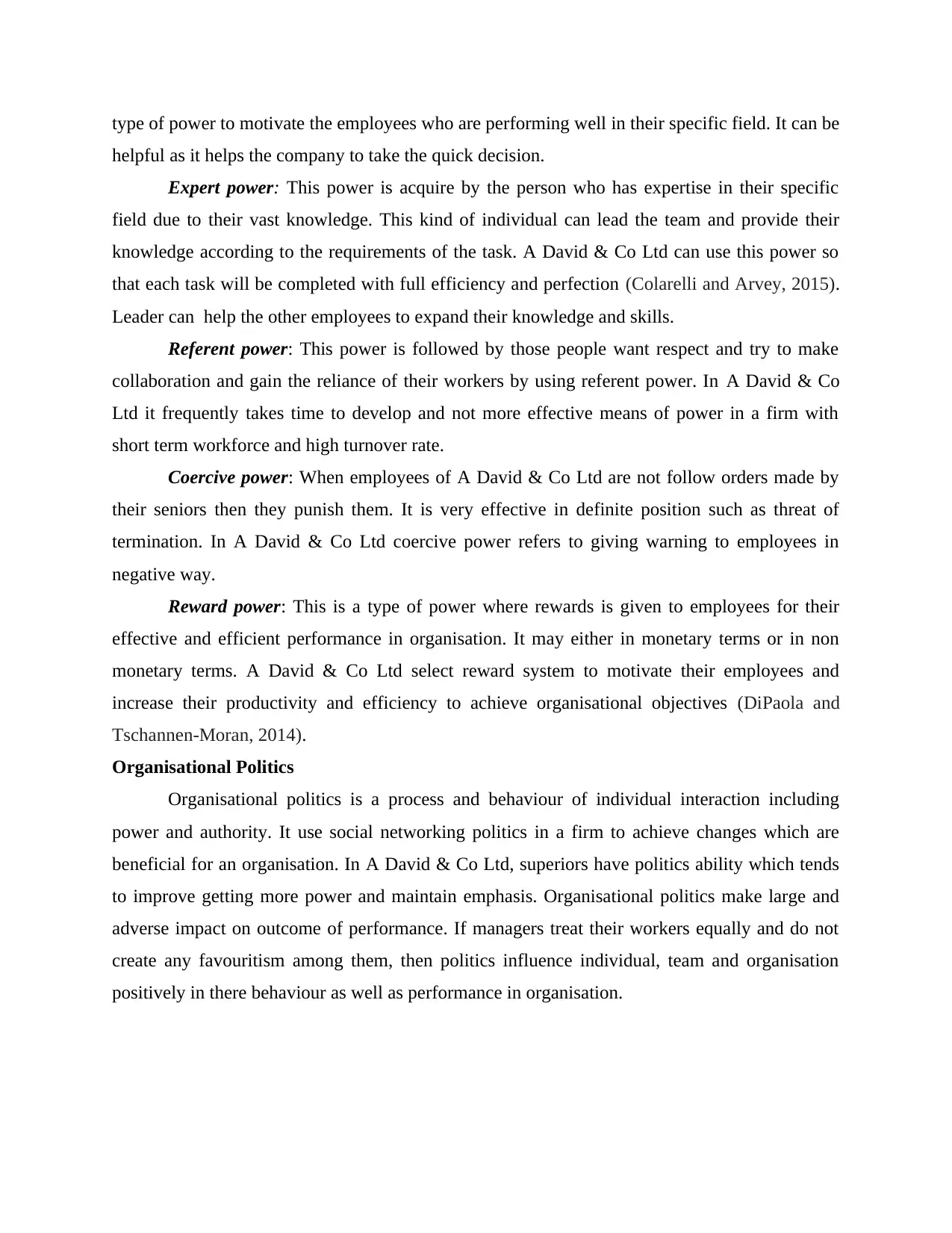
type of power to motivate the employees who are performing well in their specific field. It can be
helpful as it helps the company to take the quick decision.
Expert power: This power is acquire by the person who has expertise in their specific
field due to their vast knowledge. This kind of individual can lead the team and provide their
knowledge according to the requirements of the task. A David & Co Ltd can use this power so
that each task will be completed with full efficiency and perfection (Colarelli and Arvey, 2015).
Leader can help the other employees to expand their knowledge and skills.
Referent power: This power is followed by those people want respect and try to make
collaboration and gain the reliance of their workers by using referent power. In A David & Co
Ltd it frequently takes time to develop and not more effective means of power in a firm with
short term workforce and high turnover rate.
Coercive power: When employees of A David & Co Ltd are not follow orders made by
their seniors then they punish them. It is very effective in definite position such as threat of
termination. In A David & Co Ltd coercive power refers to giving warning to employees in
negative way.
Reward power: This is a type of power where rewards is given to employees for their
effective and efficient performance in organisation. It may either in monetary terms or in non
monetary terms. A David & Co Ltd select reward system to motivate their employees and
increase their productivity and efficiency to achieve organisational objectives (DiPaola and
Tschannen-Moran, 2014).
Organisational Politics
Organisational politics is a process and behaviour of individual interaction including
power and authority. It use social networking politics in a firm to achieve changes which are
beneficial for an organisation. In A David & Co Ltd, superiors have politics ability which tends
to improve getting more power and maintain emphasis. Organisational politics make large and
adverse impact on outcome of performance. If managers treat their workers equally and do not
create any favouritism among them, then politics influence individual, team and organisation
positively in there behaviour as well as performance in organisation.
helpful as it helps the company to take the quick decision.
Expert power: This power is acquire by the person who has expertise in their specific
field due to their vast knowledge. This kind of individual can lead the team and provide their
knowledge according to the requirements of the task. A David & Co Ltd can use this power so
that each task will be completed with full efficiency and perfection (Colarelli and Arvey, 2015).
Leader can help the other employees to expand their knowledge and skills.
Referent power: This power is followed by those people want respect and try to make
collaboration and gain the reliance of their workers by using referent power. In A David & Co
Ltd it frequently takes time to develop and not more effective means of power in a firm with
short term workforce and high turnover rate.
Coercive power: When employees of A David & Co Ltd are not follow orders made by
their seniors then they punish them. It is very effective in definite position such as threat of
termination. In A David & Co Ltd coercive power refers to giving warning to employees in
negative way.
Reward power: This is a type of power where rewards is given to employees for their
effective and efficient performance in organisation. It may either in monetary terms or in non
monetary terms. A David & Co Ltd select reward system to motivate their employees and
increase their productivity and efficiency to achieve organisational objectives (DiPaola and
Tschannen-Moran, 2014).
Organisational Politics
Organisational politics is a process and behaviour of individual interaction including
power and authority. It use social networking politics in a firm to achieve changes which are
beneficial for an organisation. In A David & Co Ltd, superiors have politics ability which tends
to improve getting more power and maintain emphasis. Organisational politics make large and
adverse impact on outcome of performance. If managers treat their workers equally and do not
create any favouritism among them, then politics influence individual, team and organisation
positively in there behaviour as well as performance in organisation.
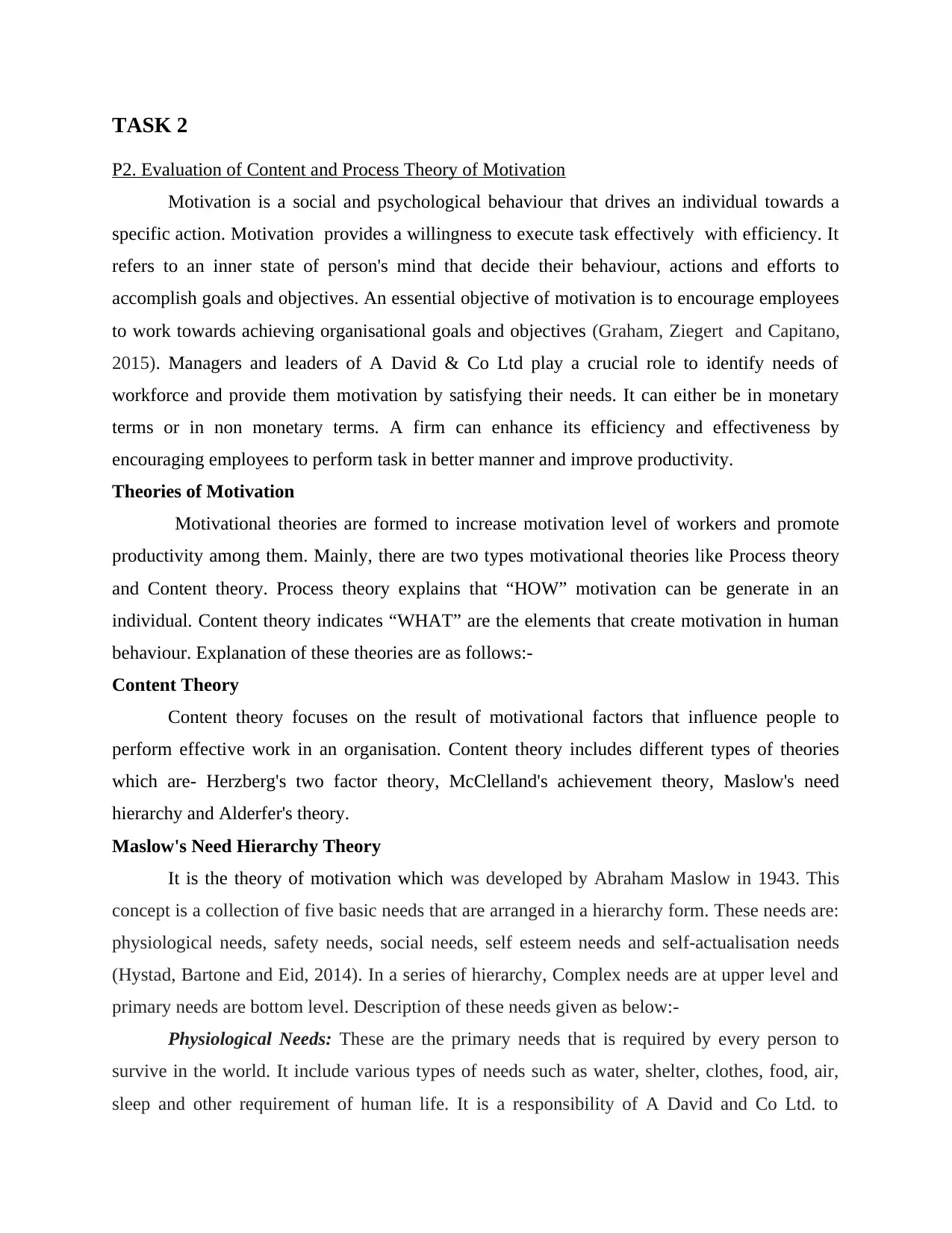
TASK 2
P2. Evaluation of Content and Process Theory of Motivation
Motivation is a social and psychological behaviour that drives an individual towards a
specific action. Motivation provides a willingness to execute task effectively with efficiency. It
refers to an inner state of person's mind that decide their behaviour, actions and efforts to
accomplish goals and objectives. An essential objective of motivation is to encourage employees
to work towards achieving organisational goals and objectives (Graham, Ziegert and Capitano,
2015). Managers and leaders of A David & Co Ltd play a crucial role to identify needs of
workforce and provide them motivation by satisfying their needs. It can either be in monetary
terms or in non monetary terms. A firm can enhance its efficiency and effectiveness by
encouraging employees to perform task in better manner and improve productivity.
Theories of Motivation
Motivational theories are formed to increase motivation level of workers and promote
productivity among them. Mainly, there are two types motivational theories like Process theory
and Content theory. Process theory explains that “HOW” motivation can be generate in an
individual. Content theory indicates “WHAT” are the elements that create motivation in human
behaviour. Explanation of these theories are as follows:-
Content Theory
Content theory focuses on the result of motivational factors that influence people to
perform effective work in an organisation. Content theory includes different types of theories
which are- Herzberg's two factor theory, McClelland's achievement theory, Maslow's need
hierarchy and Alderfer's theory.
Maslow's Need Hierarchy Theory
It is the theory of motivation which was developed by Abraham Maslow in 1943. This
concept is a collection of five basic needs that are arranged in a hierarchy form. These needs are:
physiological needs, safety needs, social needs, self esteem needs and self-actualisation needs
(Hystad, Bartone and Eid, 2014). In a series of hierarchy, Complex needs are at upper level and
primary needs are bottom level. Description of these needs given as below:-
Physiological Needs: These are the primary needs that is required by every person to
survive in the world. It include various types of needs such as water, shelter, clothes, food, air,
sleep and other requirement of human life. It is a responsibility of A David and Co Ltd. to
P2. Evaluation of Content and Process Theory of Motivation
Motivation is a social and psychological behaviour that drives an individual towards a
specific action. Motivation provides a willingness to execute task effectively with efficiency. It
refers to an inner state of person's mind that decide their behaviour, actions and efforts to
accomplish goals and objectives. An essential objective of motivation is to encourage employees
to work towards achieving organisational goals and objectives (Graham, Ziegert and Capitano,
2015). Managers and leaders of A David & Co Ltd play a crucial role to identify needs of
workforce and provide them motivation by satisfying their needs. It can either be in monetary
terms or in non monetary terms. A firm can enhance its efficiency and effectiveness by
encouraging employees to perform task in better manner and improve productivity.
Theories of Motivation
Motivational theories are formed to increase motivation level of workers and promote
productivity among them. Mainly, there are two types motivational theories like Process theory
and Content theory. Process theory explains that “HOW” motivation can be generate in an
individual. Content theory indicates “WHAT” are the elements that create motivation in human
behaviour. Explanation of these theories are as follows:-
Content Theory
Content theory focuses on the result of motivational factors that influence people to
perform effective work in an organisation. Content theory includes different types of theories
which are- Herzberg's two factor theory, McClelland's achievement theory, Maslow's need
hierarchy and Alderfer's theory.
Maslow's Need Hierarchy Theory
It is the theory of motivation which was developed by Abraham Maslow in 1943. This
concept is a collection of five basic needs that are arranged in a hierarchy form. These needs are:
physiological needs, safety needs, social needs, self esteem needs and self-actualisation needs
(Hystad, Bartone and Eid, 2014). In a series of hierarchy, Complex needs are at upper level and
primary needs are bottom level. Description of these needs given as below:-
Physiological Needs: These are the primary needs that is required by every person to
survive in the world. It include various types of needs such as water, shelter, clothes, food, air,
sleep and other requirement of human life. It is a responsibility of A David and Co Ltd. to
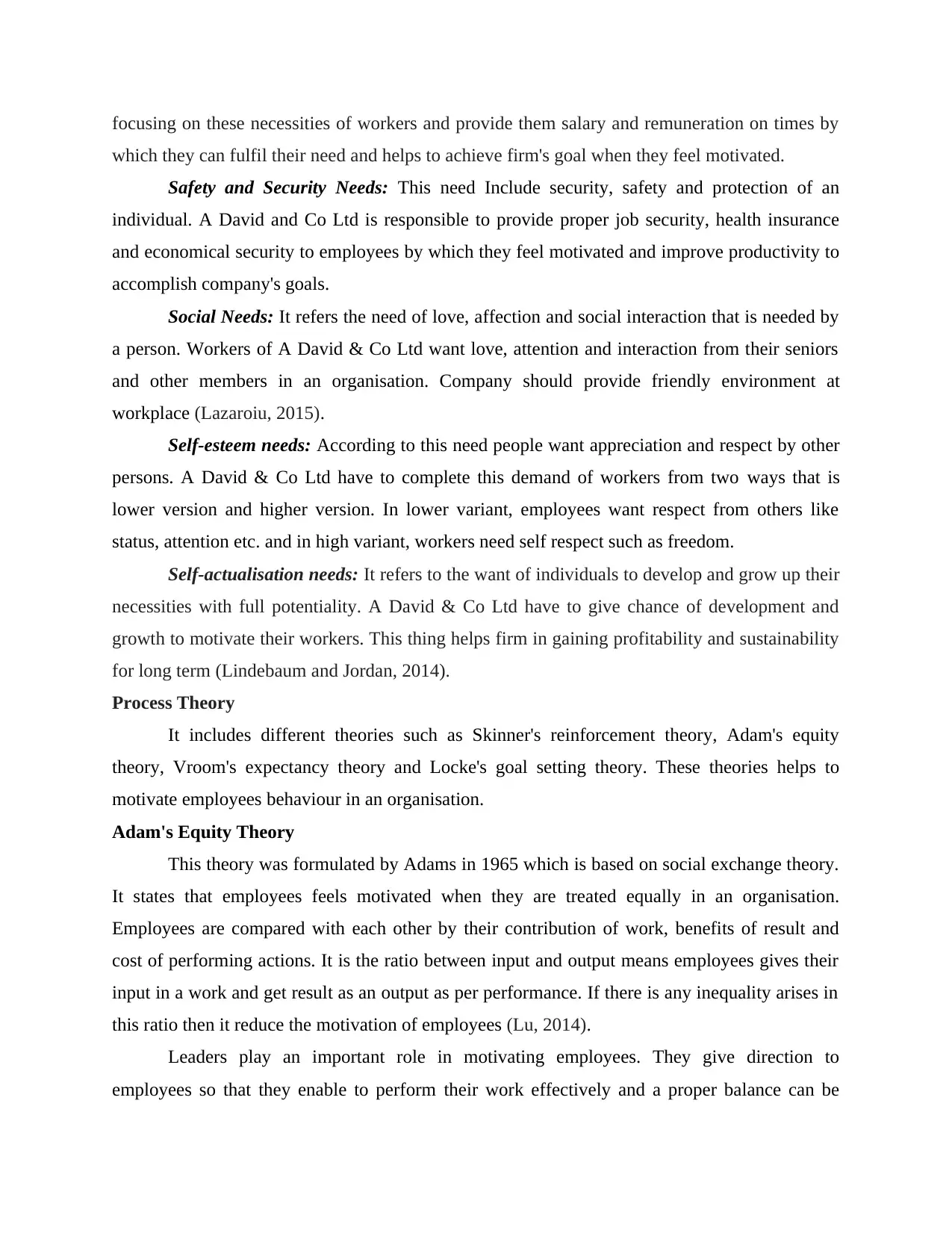
focusing on these necessities of workers and provide them salary and remuneration on times by
which they can fulfil their need and helps to achieve firm's goal when they feel motivated.
Safety and Security Needs: This need Include security, safety and protection of an
individual. A David and Co Ltd is responsible to provide proper job security, health insurance
and economical security to employees by which they feel motivated and improve productivity to
accomplish company's goals.
Social Needs: It refers the need of love, affection and social interaction that is needed by
a person. Workers of A David & Co Ltd want love, attention and interaction from their seniors
and other members in an organisation. Company should provide friendly environment at
workplace (Lazaroiu, 2015).
Self-esteem needs: According to this need people want appreciation and respect by other
persons. A David & Co Ltd have to complete this demand of workers from two ways that is
lower version and higher version. In lower variant, employees want respect from others like
status, attention etc. and in high variant, workers need self respect such as freedom.
Self-actualisation needs: It refers to the want of individuals to develop and grow up their
necessities with full potentiality. A David & Co Ltd have to give chance of development and
growth to motivate their workers. This thing helps firm in gaining profitability and sustainability
for long term (Lindebaum and Jordan, 2014).
Process Theory
It includes different theories such as Skinner's reinforcement theory, Adam's equity
theory, Vroom's expectancy theory and Locke's goal setting theory. These theories helps to
motivate employees behaviour in an organisation.
Adam's Equity Theory
This theory was formulated by Adams in 1965 which is based on social exchange theory.
It states that employees feels motivated when they are treated equally in an organisation.
Employees are compared with each other by their contribution of work, benefits of result and
cost of performing actions. It is the ratio between input and output means employees gives their
input in a work and get result as an output as per performance. If there is any inequality arises in
this ratio then it reduce the motivation of employees (Lu, 2014).
Leaders play an important role in motivating employees. They give direction to
employees so that they enable to perform their work effectively and a proper balance can be
which they can fulfil their need and helps to achieve firm's goal when they feel motivated.
Safety and Security Needs: This need Include security, safety and protection of an
individual. A David and Co Ltd is responsible to provide proper job security, health insurance
and economical security to employees by which they feel motivated and improve productivity to
accomplish company's goals.
Social Needs: It refers the need of love, affection and social interaction that is needed by
a person. Workers of A David & Co Ltd want love, attention and interaction from their seniors
and other members in an organisation. Company should provide friendly environment at
workplace (Lazaroiu, 2015).
Self-esteem needs: According to this need people want appreciation and respect by other
persons. A David & Co Ltd have to complete this demand of workers from two ways that is
lower version and higher version. In lower variant, employees want respect from others like
status, attention etc. and in high variant, workers need self respect such as freedom.
Self-actualisation needs: It refers to the want of individuals to develop and grow up their
necessities with full potentiality. A David & Co Ltd have to give chance of development and
growth to motivate their workers. This thing helps firm in gaining profitability and sustainability
for long term (Lindebaum and Jordan, 2014).
Process Theory
It includes different theories such as Skinner's reinforcement theory, Adam's equity
theory, Vroom's expectancy theory and Locke's goal setting theory. These theories helps to
motivate employees behaviour in an organisation.
Adam's Equity Theory
This theory was formulated by Adams in 1965 which is based on social exchange theory.
It states that employees feels motivated when they are treated equally in an organisation.
Employees are compared with each other by their contribution of work, benefits of result and
cost of performing actions. It is the ratio between input and output means employees gives their
input in a work and get result as an output as per performance. If there is any inequality arises in
this ratio then it reduce the motivation of employees (Lu, 2014).
Leaders play an important role in motivating employees. They give direction to
employees so that they enable to perform their work effectively and a proper balance can be
Paraphrase This Document
Need a fresh take? Get an instant paraphrase of this document with our AI Paraphraser
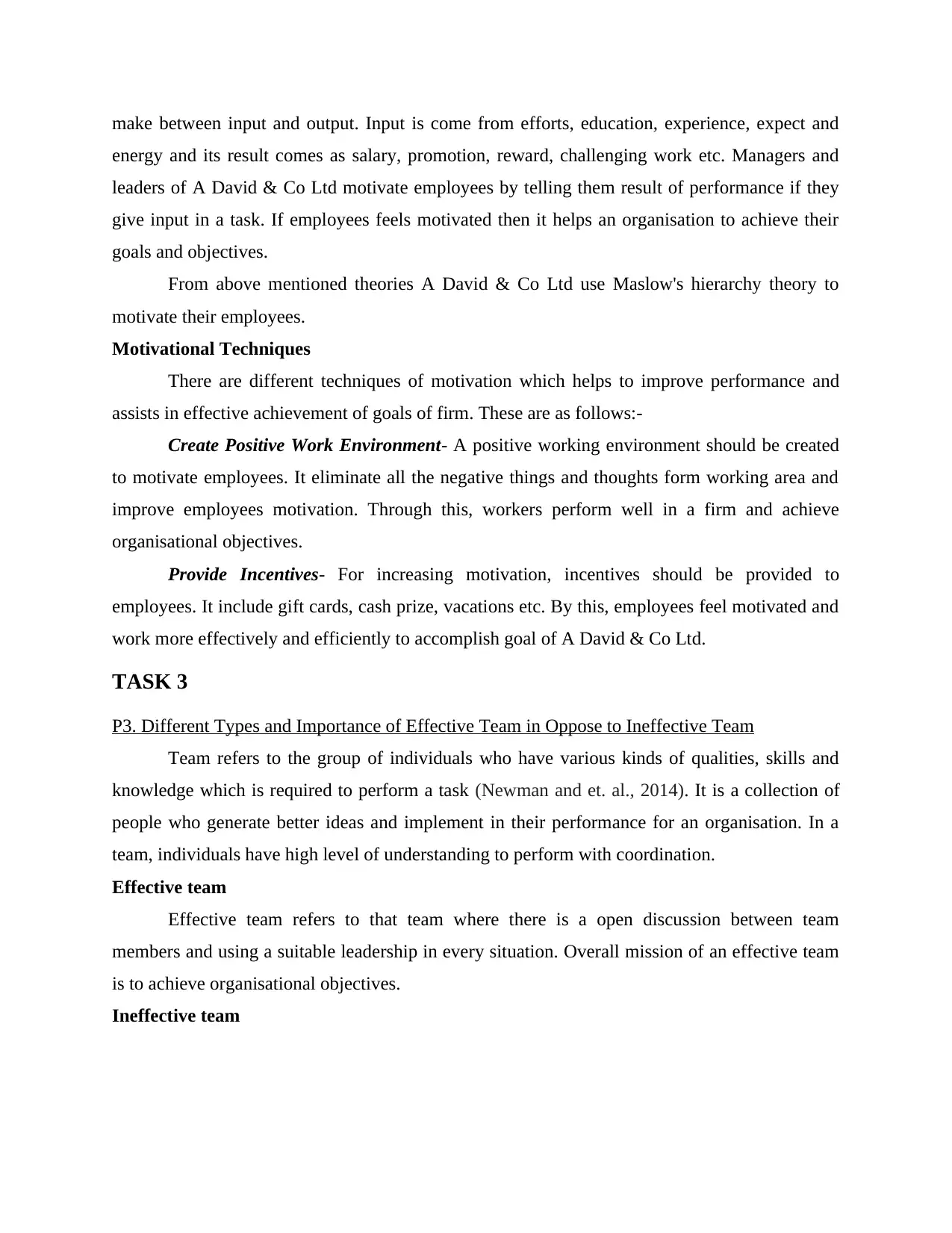
make between input and output. Input is come from efforts, education, experience, expect and
energy and its result comes as salary, promotion, reward, challenging work etc. Managers and
leaders of A David & Co Ltd motivate employees by telling them result of performance if they
give input in a task. If employees feels motivated then it helps an organisation to achieve their
goals and objectives.
From above mentioned theories A David & Co Ltd use Maslow's hierarchy theory to
motivate their employees.
Motivational Techniques
There are different techniques of motivation which helps to improve performance and
assists in effective achievement of goals of firm. These are as follows:-
Create Positive Work Environment- A positive working environment should be created
to motivate employees. It eliminate all the negative things and thoughts form working area and
improve employees motivation. Through this, workers perform well in a firm and achieve
organisational objectives.
Provide Incentives- For increasing motivation, incentives should be provided to
employees. It include gift cards, cash prize, vacations etc. By this, employees feel motivated and
work more effectively and efficiently to accomplish goal of A David & Co Ltd.
TASK 3
P3. Different Types and Importance of Effective Team in Oppose to Ineffective Team
Team refers to the group of individuals who have various kinds of qualities, skills and
knowledge which is required to perform a task (Newman and et. al., 2014). It is a collection of
people who generate better ideas and implement in their performance for an organisation. In a
team, individuals have high level of understanding to perform with coordination.
Effective team
Effective team refers to that team where there is a open discussion between team
members and using a suitable leadership in every situation. Overall mission of an effective team
is to achieve organisational objectives.
Ineffective team
energy and its result comes as salary, promotion, reward, challenging work etc. Managers and
leaders of A David & Co Ltd motivate employees by telling them result of performance if they
give input in a task. If employees feels motivated then it helps an organisation to achieve their
goals and objectives.
From above mentioned theories A David & Co Ltd use Maslow's hierarchy theory to
motivate their employees.
Motivational Techniques
There are different techniques of motivation which helps to improve performance and
assists in effective achievement of goals of firm. These are as follows:-
Create Positive Work Environment- A positive working environment should be created
to motivate employees. It eliminate all the negative things and thoughts form working area and
improve employees motivation. Through this, workers perform well in a firm and achieve
organisational objectives.
Provide Incentives- For increasing motivation, incentives should be provided to
employees. It include gift cards, cash prize, vacations etc. By this, employees feel motivated and
work more effectively and efficiently to accomplish goal of A David & Co Ltd.
TASK 3
P3. Different Types and Importance of Effective Team in Oppose to Ineffective Team
Team refers to the group of individuals who have various kinds of qualities, skills and
knowledge which is required to perform a task (Newman and et. al., 2014). It is a collection of
people who generate better ideas and implement in their performance for an organisation. In a
team, individuals have high level of understanding to perform with coordination.
Effective team
Effective team refers to that team where there is a open discussion between team
members and using a suitable leadership in every situation. Overall mission of an effective team
is to achieve organisational objectives.
Ineffective team
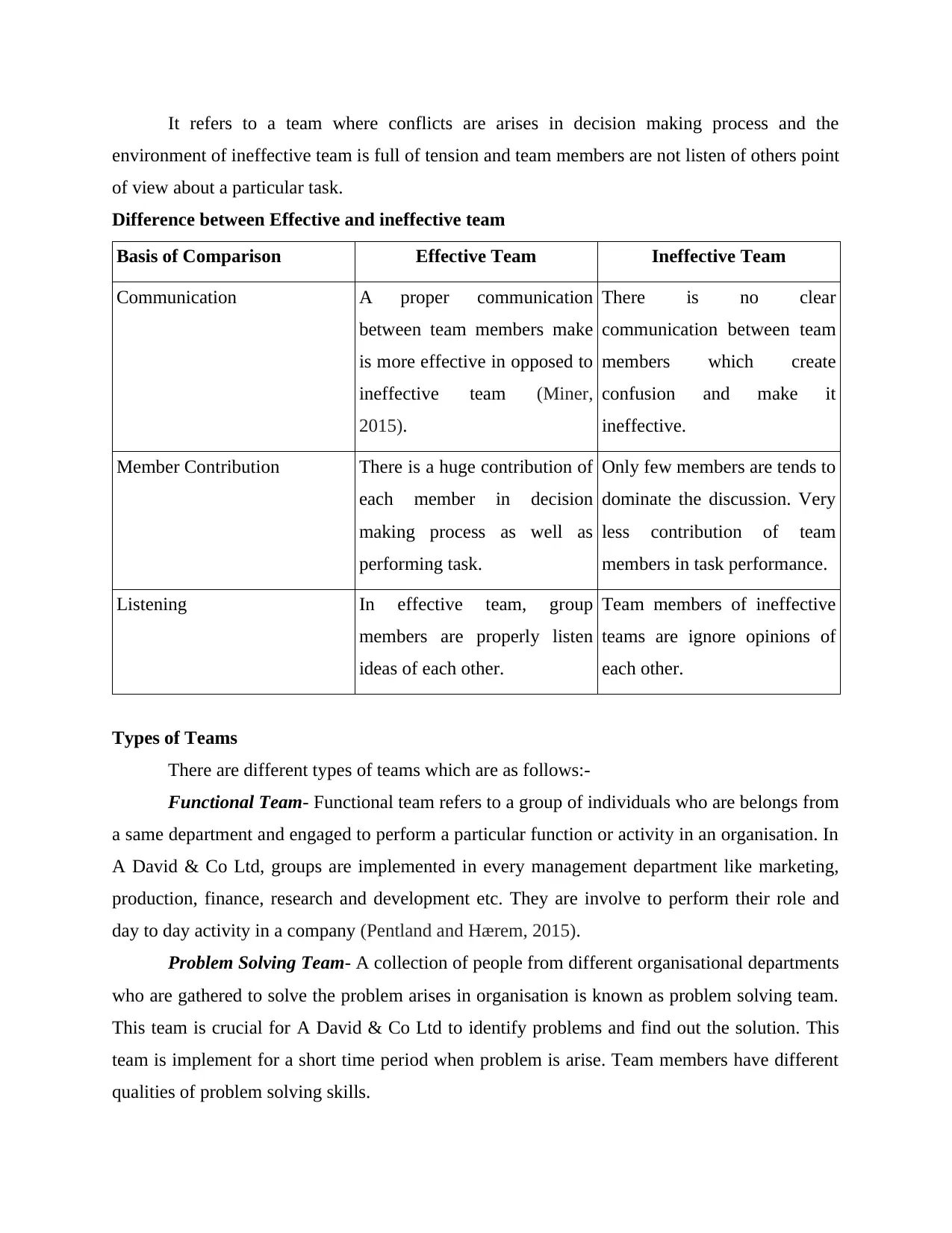
It refers to a team where conflicts are arises in decision making process and the
environment of ineffective team is full of tension and team members are not listen of others point
of view about a particular task.
Difference between Effective and ineffective team
Basis of Comparison Effective Team Ineffective Team
Communication A proper communication
between team members make
is more effective in opposed to
ineffective team (Miner,
2015).
There is no clear
communication between team
members which create
confusion and make it
ineffective.
Member Contribution There is a huge contribution of
each member in decision
making process as well as
performing task.
Only few members are tends to
dominate the discussion. Very
less contribution of team
members in task performance.
Listening In effective team, group
members are properly listen
ideas of each other.
Team members of ineffective
teams are ignore opinions of
each other.
Types of Teams
There are different types of teams which are as follows:-
Functional Team- Functional team refers to a group of individuals who are belongs from
a same department and engaged to perform a particular function or activity in an organisation. In
A David & Co Ltd, groups are implemented in every management department like marketing,
production, finance, research and development etc. They are involve to perform their role and
day to day activity in a company (Pentland and Hærem, 2015).
Problem Solving Team- A collection of people from different organisational departments
who are gathered to solve the problem arises in organisation is known as problem solving team.
This team is crucial for A David & Co Ltd to identify problems and find out the solution. This
team is implement for a short time period when problem is arise. Team members have different
qualities of problem solving skills.
environment of ineffective team is full of tension and team members are not listen of others point
of view about a particular task.
Difference between Effective and ineffective team
Basis of Comparison Effective Team Ineffective Team
Communication A proper communication
between team members make
is more effective in opposed to
ineffective team (Miner,
2015).
There is no clear
communication between team
members which create
confusion and make it
ineffective.
Member Contribution There is a huge contribution of
each member in decision
making process as well as
performing task.
Only few members are tends to
dominate the discussion. Very
less contribution of team
members in task performance.
Listening In effective team, group
members are properly listen
ideas of each other.
Team members of ineffective
teams are ignore opinions of
each other.
Types of Teams
There are different types of teams which are as follows:-
Functional Team- Functional team refers to a group of individuals who are belongs from
a same department and engaged to perform a particular function or activity in an organisation. In
A David & Co Ltd, groups are implemented in every management department like marketing,
production, finance, research and development etc. They are involve to perform their role and
day to day activity in a company (Pentland and Hærem, 2015).
Problem Solving Team- A collection of people from different organisational departments
who are gathered to solve the problem arises in organisation is known as problem solving team.
This team is crucial for A David & Co Ltd to identify problems and find out the solution. This
team is implement for a short time period when problem is arise. Team members have different
qualities of problem solving skills.
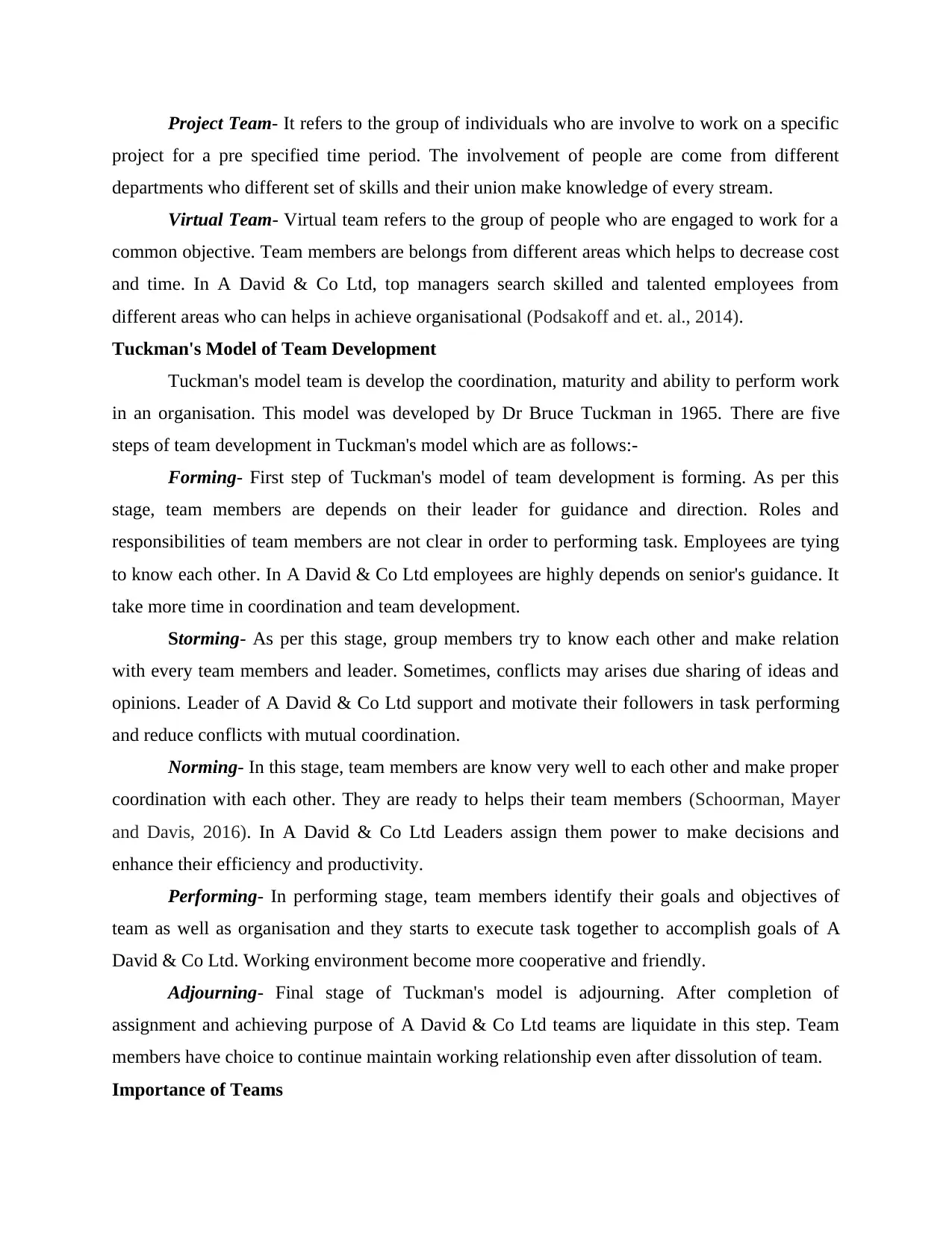
Project Team- It refers to the group of individuals who are involve to work on a specific
project for a pre specified time period. The involvement of people are come from different
departments who different set of skills and their union make knowledge of every stream.
Virtual Team- Virtual team refers to the group of people who are engaged to work for a
common objective. Team members are belongs from different areas which helps to decrease cost
and time. In A David & Co Ltd, top managers search skilled and talented employees from
different areas who can helps in achieve organisational (Podsakoff and et. al., 2014).
Tuckman's Model of Team Development
Tuckman's model team is develop the coordination, maturity and ability to perform work
in an organisation. This model was developed by Dr Bruce Tuckman in 1965. There are five
steps of team development in Tuckman's model which are as follows:-
Forming- First step of Tuckman's model of team development is forming. As per this
stage, team members are depends on their leader for guidance and direction. Roles and
responsibilities of team members are not clear in order to performing task. Employees are tying
to know each other. In A David & Co Ltd employees are highly depends on senior's guidance. It
take more time in coordination and team development.
Storming- As per this stage, group members try to know each other and make relation
with every team members and leader. Sometimes, conflicts may arises due sharing of ideas and
opinions. Leader of A David & Co Ltd support and motivate their followers in task performing
and reduce conflicts with mutual coordination.
Norming- In this stage, team members are know very well to each other and make proper
coordination with each other. They are ready to helps their team members (Schoorman, Mayer
and Davis, 2016). In A David & Co Ltd Leaders assign them power to make decisions and
enhance their efficiency and productivity.
Performing- In performing stage, team members identify their goals and objectives of
team as well as organisation and they starts to execute task together to accomplish goals of A
David & Co Ltd. Working environment become more cooperative and friendly.
Adjourning- Final stage of Tuckman's model is adjourning. After completion of
assignment and achieving purpose of A David & Co Ltd teams are liquidate in this step. Team
members have choice to continue maintain working relationship even after dissolution of team.
Importance of Teams
project for a pre specified time period. The involvement of people are come from different
departments who different set of skills and their union make knowledge of every stream.
Virtual Team- Virtual team refers to the group of people who are engaged to work for a
common objective. Team members are belongs from different areas which helps to decrease cost
and time. In A David & Co Ltd, top managers search skilled and talented employees from
different areas who can helps in achieve organisational (Podsakoff and et. al., 2014).
Tuckman's Model of Team Development
Tuckman's model team is develop the coordination, maturity and ability to perform work
in an organisation. This model was developed by Dr Bruce Tuckman in 1965. There are five
steps of team development in Tuckman's model which are as follows:-
Forming- First step of Tuckman's model of team development is forming. As per this
stage, team members are depends on their leader for guidance and direction. Roles and
responsibilities of team members are not clear in order to performing task. Employees are tying
to know each other. In A David & Co Ltd employees are highly depends on senior's guidance. It
take more time in coordination and team development.
Storming- As per this stage, group members try to know each other and make relation
with every team members and leader. Sometimes, conflicts may arises due sharing of ideas and
opinions. Leader of A David & Co Ltd support and motivate their followers in task performing
and reduce conflicts with mutual coordination.
Norming- In this stage, team members are know very well to each other and make proper
coordination with each other. They are ready to helps their team members (Schoorman, Mayer
and Davis, 2016). In A David & Co Ltd Leaders assign them power to make decisions and
enhance their efficiency and productivity.
Performing- In performing stage, team members identify their goals and objectives of
team as well as organisation and they starts to execute task together to accomplish goals of A
David & Co Ltd. Working environment become more cooperative and friendly.
Adjourning- Final stage of Tuckman's model is adjourning. After completion of
assignment and achieving purpose of A David & Co Ltd teams are liquidate in this step. Team
members have choice to continue maintain working relationship even after dissolution of team.
Importance of Teams
Secure Best Marks with AI Grader
Need help grading? Try our AI Grader for instant feedback on your assignments.
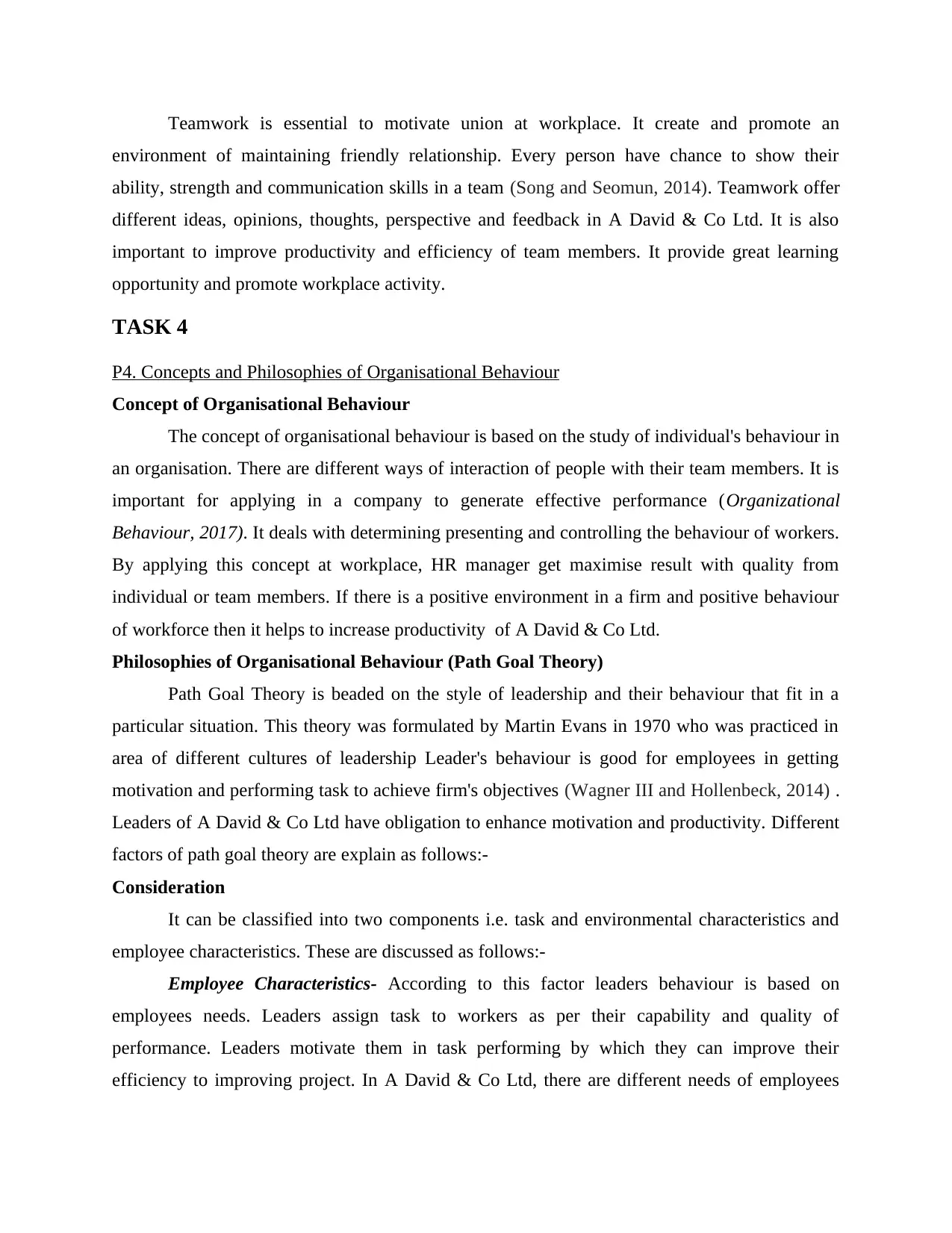
Teamwork is essential to motivate union at workplace. It create and promote an
environment of maintaining friendly relationship. Every person have chance to show their
ability, strength and communication skills in a team (Song and Seomun, 2014). Teamwork offer
different ideas, opinions, thoughts, perspective and feedback in A David & Co Ltd. It is also
important to improve productivity and efficiency of team members. It provide great learning
opportunity and promote workplace activity.
TASK 4
P4. Concepts and Philosophies of Organisational Behaviour
Concept of Organisational Behaviour
The concept of organisational behaviour is based on the study of individual's behaviour in
an organisation. There are different ways of interaction of people with their team members. It is
important for applying in a company to generate effective performance (Organizational
Behaviour, 2017). It deals with determining presenting and controlling the behaviour of workers.
By applying this concept at workplace, HR manager get maximise result with quality from
individual or team members. If there is a positive environment in a firm and positive behaviour
of workforce then it helps to increase productivity of A David & Co Ltd.
Philosophies of Organisational Behaviour (Path Goal Theory)
Path Goal Theory is beaded on the style of leadership and their behaviour that fit in a
particular situation. This theory was formulated by Martin Evans in 1970 who was practiced in
area of different cultures of leadership Leader's behaviour is good for employees in getting
motivation and performing task to achieve firm's objectives (Wagner III and Hollenbeck, 2014) .
Leaders of A David & Co Ltd have obligation to enhance motivation and productivity. Different
factors of path goal theory are explain as follows:-
Consideration
It can be classified into two components i.e. task and environmental characteristics and
employee characteristics. These are discussed as follows:-
Employee Characteristics- According to this factor leaders behaviour is based on
employees needs. Leaders assign task to workers as per their capability and quality of
performance. Leaders motivate them in task performing by which they can improve their
efficiency to improving project. In A David & Co Ltd, there are different needs of employees
environment of maintaining friendly relationship. Every person have chance to show their
ability, strength and communication skills in a team (Song and Seomun, 2014). Teamwork offer
different ideas, opinions, thoughts, perspective and feedback in A David & Co Ltd. It is also
important to improve productivity and efficiency of team members. It provide great learning
opportunity and promote workplace activity.
TASK 4
P4. Concepts and Philosophies of Organisational Behaviour
Concept of Organisational Behaviour
The concept of organisational behaviour is based on the study of individual's behaviour in
an organisation. There are different ways of interaction of people with their team members. It is
important for applying in a company to generate effective performance (Organizational
Behaviour, 2017). It deals with determining presenting and controlling the behaviour of workers.
By applying this concept at workplace, HR manager get maximise result with quality from
individual or team members. If there is a positive environment in a firm and positive behaviour
of workforce then it helps to increase productivity of A David & Co Ltd.
Philosophies of Organisational Behaviour (Path Goal Theory)
Path Goal Theory is beaded on the style of leadership and their behaviour that fit in a
particular situation. This theory was formulated by Martin Evans in 1970 who was practiced in
area of different cultures of leadership Leader's behaviour is good for employees in getting
motivation and performing task to achieve firm's objectives (Wagner III and Hollenbeck, 2014) .
Leaders of A David & Co Ltd have obligation to enhance motivation and productivity. Different
factors of path goal theory are explain as follows:-
Consideration
It can be classified into two components i.e. task and environmental characteristics and
employee characteristics. These are discussed as follows:-
Employee Characteristics- According to this factor leaders behaviour is based on
employees needs. Leaders assign task to workers as per their capability and quality of
performance. Leaders motivate them in task performing by which they can improve their
efficiency to improving project. In A David & Co Ltd, there are different needs of employees
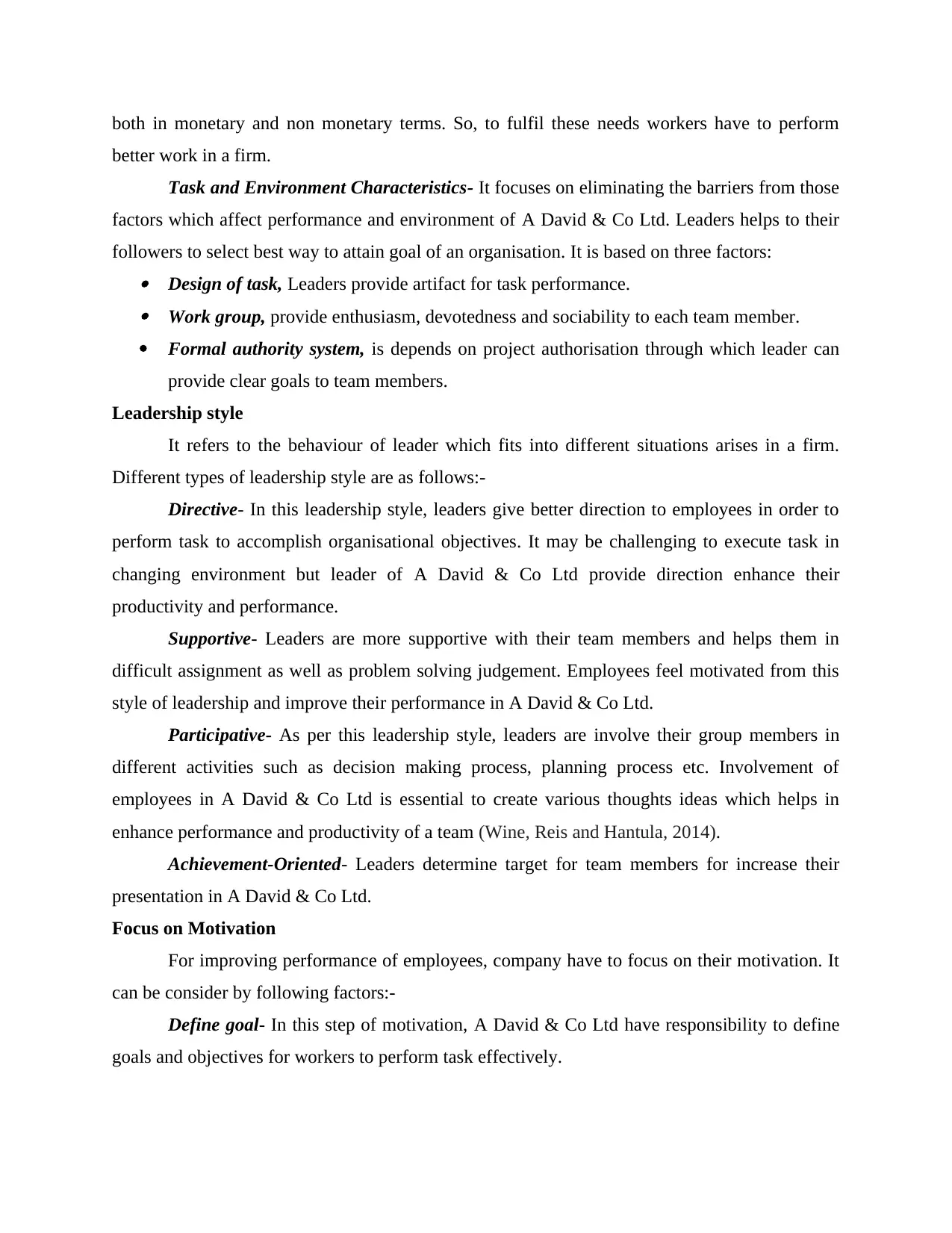
both in monetary and non monetary terms. So, to fulfil these needs workers have to perform
better work in a firm.
Task and Environment Characteristics- It focuses on eliminating the barriers from those
factors which affect performance and environment of A David & Co Ltd. Leaders helps to their
followers to select best way to attain goal of an organisation. It is based on three factors: Design of task, Leaders provide artifact for task performance. Work group, provide enthusiasm, devotedness and sociability to each team member.
Formal authority system, is depends on project authorisation through which leader can
provide clear goals to team members.
Leadership style
It refers to the behaviour of leader which fits into different situations arises in a firm.
Different types of leadership style are as follows:-
Directive- In this leadership style, leaders give better direction to employees in order to
perform task to accomplish organisational objectives. It may be challenging to execute task in
changing environment but leader of A David & Co Ltd provide direction enhance their
productivity and performance.
Supportive- Leaders are more supportive with their team members and helps them in
difficult assignment as well as problem solving judgement. Employees feel motivated from this
style of leadership and improve their performance in A David & Co Ltd.
Participative- As per this leadership style, leaders are involve their group members in
different activities such as decision making process, planning process etc. Involvement of
employees in A David & Co Ltd is essential to create various thoughts ideas which helps in
enhance performance and productivity of a team (Wine, Reis and Hantula, 2014).
Achievement-Oriented- Leaders determine target for team members for increase their
presentation in A David & Co Ltd.
Focus on Motivation
For improving performance of employees, company have to focus on their motivation. It
can be consider by following factors:-
Define goal- In this step of motivation, A David & Co Ltd have responsibility to define
goals and objectives for workers to perform task effectively.
better work in a firm.
Task and Environment Characteristics- It focuses on eliminating the barriers from those
factors which affect performance and environment of A David & Co Ltd. Leaders helps to their
followers to select best way to attain goal of an organisation. It is based on three factors: Design of task, Leaders provide artifact for task performance. Work group, provide enthusiasm, devotedness and sociability to each team member.
Formal authority system, is depends on project authorisation through which leader can
provide clear goals to team members.
Leadership style
It refers to the behaviour of leader which fits into different situations arises in a firm.
Different types of leadership style are as follows:-
Directive- In this leadership style, leaders give better direction to employees in order to
perform task to accomplish organisational objectives. It may be challenging to execute task in
changing environment but leader of A David & Co Ltd provide direction enhance their
productivity and performance.
Supportive- Leaders are more supportive with their team members and helps them in
difficult assignment as well as problem solving judgement. Employees feel motivated from this
style of leadership and improve their performance in A David & Co Ltd.
Participative- As per this leadership style, leaders are involve their group members in
different activities such as decision making process, planning process etc. Involvement of
employees in A David & Co Ltd is essential to create various thoughts ideas which helps in
enhance performance and productivity of a team (Wine, Reis and Hantula, 2014).
Achievement-Oriented- Leaders determine target for team members for increase their
presentation in A David & Co Ltd.
Focus on Motivation
For improving performance of employees, company have to focus on their motivation. It
can be consider by following factors:-
Define goal- In this step of motivation, A David & Co Ltd have responsibility to define
goals and objectives for workers to perform task effectively.
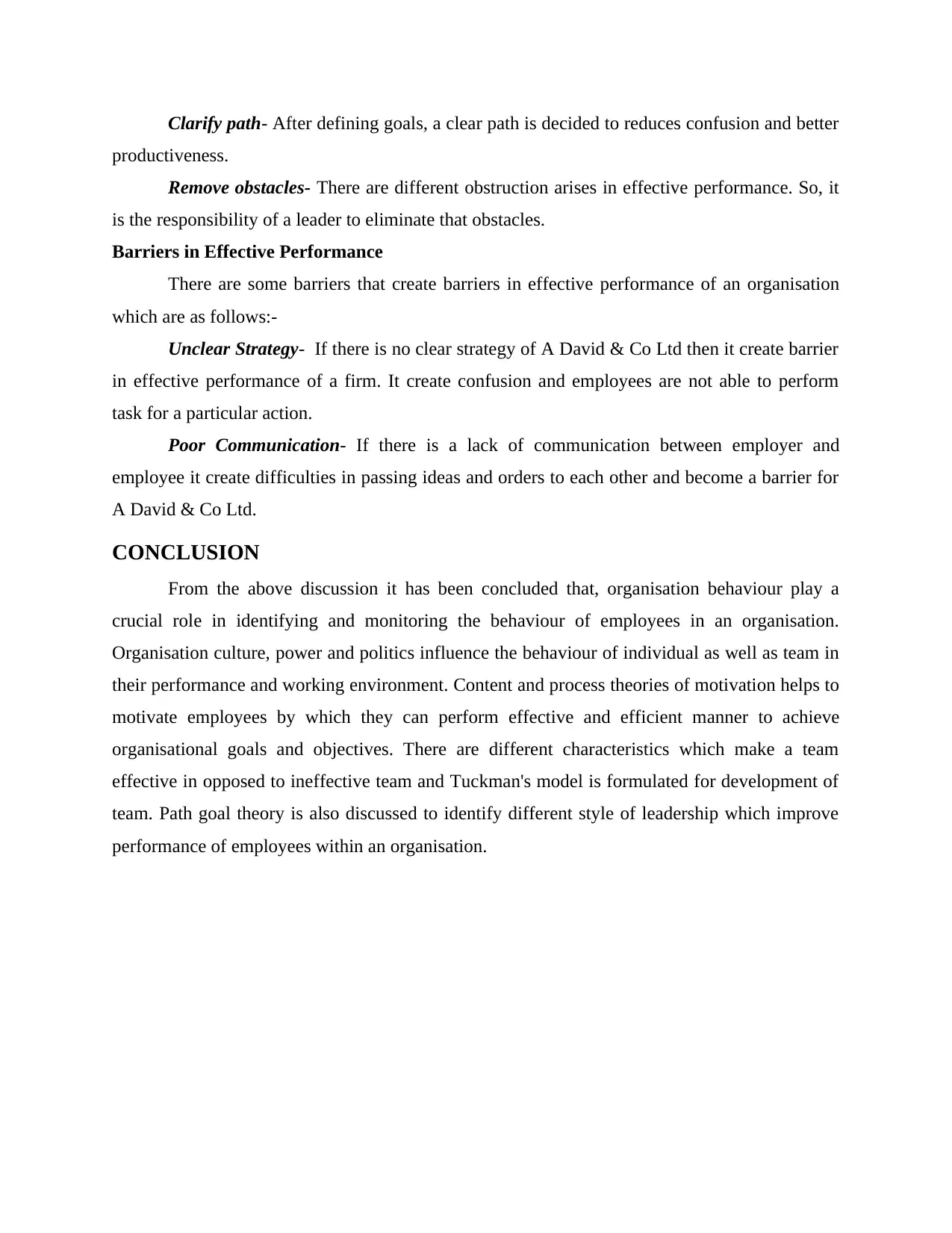
Clarify path- After defining goals, a clear path is decided to reduces confusion and better
productiveness.
Remove obstacles- There are different obstruction arises in effective performance. So, it
is the responsibility of a leader to eliminate that obstacles.
Barriers in Effective Performance
There are some barriers that create barriers in effective performance of an organisation
which are as follows:-
Unclear Strategy- If there is no clear strategy of A David & Co Ltd then it create barrier
in effective performance of a firm. It create confusion and employees are not able to perform
task for a particular action.
Poor Communication- If there is a lack of communication between employer and
employee it create difficulties in passing ideas and orders to each other and become a barrier for
A David & Co Ltd.
CONCLUSION
From the above discussion it has been concluded that, organisation behaviour play a
crucial role in identifying and monitoring the behaviour of employees in an organisation.
Organisation culture, power and politics influence the behaviour of individual as well as team in
their performance and working environment. Content and process theories of motivation helps to
motivate employees by which they can perform effective and efficient manner to achieve
organisational goals and objectives. There are different characteristics which make a team
effective in opposed to ineffective team and Tuckman's model is formulated for development of
team. Path goal theory is also discussed to identify different style of leadership which improve
performance of employees within an organisation.
productiveness.
Remove obstacles- There are different obstruction arises in effective performance. So, it
is the responsibility of a leader to eliminate that obstacles.
Barriers in Effective Performance
There are some barriers that create barriers in effective performance of an organisation
which are as follows:-
Unclear Strategy- If there is no clear strategy of A David & Co Ltd then it create barrier
in effective performance of a firm. It create confusion and employees are not able to perform
task for a particular action.
Poor Communication- If there is a lack of communication between employer and
employee it create difficulties in passing ideas and orders to each other and become a barrier for
A David & Co Ltd.
CONCLUSION
From the above discussion it has been concluded that, organisation behaviour play a
crucial role in identifying and monitoring the behaviour of employees in an organisation.
Organisation culture, power and politics influence the behaviour of individual as well as team in
their performance and working environment. Content and process theories of motivation helps to
motivate employees by which they can perform effective and efficient manner to achieve
organisational goals and objectives. There are different characteristics which make a team
effective in opposed to ineffective team and Tuckman's model is formulated for development of
team. Path goal theory is also discussed to identify different style of leadership which improve
performance of employees within an organisation.
Paraphrase This Document
Need a fresh take? Get an instant paraphrase of this document with our AI Paraphraser

REFERENCES
Books and Journals:
Becker, T. E. and et. al., 2016. Statistical control in correlational studies: 10 essential
recommendations for organizational researchers. Journal of Organizational Behavior.
37(2). pp.157-167.
Belschak, F. D., Den Hartog, D. N. and Kalshoven, K., 2015. Leading Machiavellians: How to
translate Machiavellians’ selfishness into pro-organizational behavior. Journal of
Management. 41(7). pp.1934-1956.
Borkowski, N., 2015. Organizational behavior, theory, and design in health care. Jones &
Bartlett Publishers.
Colarelli, S. M. and Arvey, R. D. eds., 2015. The biological foundations of organizational
behavior. University of Chicago Press.
DiPaola, M. and Tschannen-Moran, M., 2014. Organizational citizenship behavior in schools and
its relationship to school climate. Journal of School Leadership. 11(5). pp.424-447.
Graham, K. A., Ziegert, J. C. and Capitano, J., 2015. The effect of leadership style, framing, and
promotion regulatory focus on unethical pro-organizational behavior. Journal of
business ethics. 126(3). pp.423-436.
Hystad, S. W., Bartone, P. T. and Eid, J., 2014. Positive organizational behavior and safety in the
offshore oil industry: Exploring the determinants of positive safety climate. The journal
of positive psychology. 9(1). pp.42-53.
Lazaroiu, G., 2015. Work motivation and organizational behavior. Contemporary Readings in
Law and Social Justice. 7(2). p.66.
Lindebaum, D. and Jordan, P. J., 2014. A critique on neuroscientific methodologies in
organizational behavior and management studies. Journal of Organizational Behavior.
35(7). pp.898-908.
Lu, X., 2014. Ethical leadership and organizational citizenship behavior: The mediating roles of
cognitive and affective trust. Social Behavior and Personality: an international journal.
42(3). pp.379-389.
Miner, J. B., 2015. Organizational behavior 4: From theory to practice. Routledge.
Newman, A. and et. al., 2014. Psychological capital: A review and synthesis. Journal of
Organizational Behavior. 35(S1). pp.S120-S138.
Pentland, B. T. and Hærem, T., 2015. Organizational routines as patterns of action: Implications
for organizational behavior. Annu. Rev. Organ. Psychol. Organ. Behav.. 2(1). pp.465-
487.
Podsakoff, N. P. and et. al., 2014. Consequences of unit‐level organizational citizenship
behaviors: A review and recommendations for future research. Journal of
Organizational Behavior. 35(S1). pp.S87-S119.
Schoorman, F. D., Mayer, R. C. and Davis, J. H., 2016. Perspective: Empowerment in veterinary
clinics: the role of trust in delegation. Journal of Trust Research. 6(1). pp.91-95.
Song, B. and Seomun, G., 2014. The influential factors related to organizational citizenship
behavior of nurses: With focus on authentic leadership and organizational justice.
Journal of Korean Academy of Nursing Administration. 20(2). pp.237-246.
Wagner III, J. A. and Hollenbeck, J. R., 2014. Organizational behavior: Securing competitive
advantage. Routledge.
Books and Journals:
Becker, T. E. and et. al., 2016. Statistical control in correlational studies: 10 essential
recommendations for organizational researchers. Journal of Organizational Behavior.
37(2). pp.157-167.
Belschak, F. D., Den Hartog, D. N. and Kalshoven, K., 2015. Leading Machiavellians: How to
translate Machiavellians’ selfishness into pro-organizational behavior. Journal of
Management. 41(7). pp.1934-1956.
Borkowski, N., 2015. Organizational behavior, theory, and design in health care. Jones &
Bartlett Publishers.
Colarelli, S. M. and Arvey, R. D. eds., 2015. The biological foundations of organizational
behavior. University of Chicago Press.
DiPaola, M. and Tschannen-Moran, M., 2014. Organizational citizenship behavior in schools and
its relationship to school climate. Journal of School Leadership. 11(5). pp.424-447.
Graham, K. A., Ziegert, J. C. and Capitano, J., 2015. The effect of leadership style, framing, and
promotion regulatory focus on unethical pro-organizational behavior. Journal of
business ethics. 126(3). pp.423-436.
Hystad, S. W., Bartone, P. T. and Eid, J., 2014. Positive organizational behavior and safety in the
offshore oil industry: Exploring the determinants of positive safety climate. The journal
of positive psychology. 9(1). pp.42-53.
Lazaroiu, G., 2015. Work motivation and organizational behavior. Contemporary Readings in
Law and Social Justice. 7(2). p.66.
Lindebaum, D. and Jordan, P. J., 2014. A critique on neuroscientific methodologies in
organizational behavior and management studies. Journal of Organizational Behavior.
35(7). pp.898-908.
Lu, X., 2014. Ethical leadership and organizational citizenship behavior: The mediating roles of
cognitive and affective trust. Social Behavior and Personality: an international journal.
42(3). pp.379-389.
Miner, J. B., 2015. Organizational behavior 4: From theory to practice. Routledge.
Newman, A. and et. al., 2014. Psychological capital: A review and synthesis. Journal of
Organizational Behavior. 35(S1). pp.S120-S138.
Pentland, B. T. and Hærem, T., 2015. Organizational routines as patterns of action: Implications
for organizational behavior. Annu. Rev. Organ. Psychol. Organ. Behav.. 2(1). pp.465-
487.
Podsakoff, N. P. and et. al., 2014. Consequences of unit‐level organizational citizenship
behaviors: A review and recommendations for future research. Journal of
Organizational Behavior. 35(S1). pp.S87-S119.
Schoorman, F. D., Mayer, R. C. and Davis, J. H., 2016. Perspective: Empowerment in veterinary
clinics: the role of trust in delegation. Journal of Trust Research. 6(1). pp.91-95.
Song, B. and Seomun, G., 2014. The influential factors related to organizational citizenship
behavior of nurses: With focus on authentic leadership and organizational justice.
Journal of Korean Academy of Nursing Administration. 20(2). pp.237-246.
Wagner III, J. A. and Hollenbeck, J. R., 2014. Organizational behavior: Securing competitive
advantage. Routledge.

Wine, B., Reis, M. and Hantula, D. A., 2014. An evaluation of stimulus preference assessment
methodology in organizational behavior management. Journal of Organizational
Behavior Management. 34(1). pp.7-15.
Online
Organizational Behaviour. 2017. [Online]. Available
through:<https://iedunote.com/organizational-behavior/>.
methodology in organizational behavior management. Journal of Organizational
Behavior Management. 34(1). pp.7-15.
Online
Organizational Behaviour. 2017. [Online]. Available
through:<https://iedunote.com/organizational-behavior/>.
1 out of 15
Related Documents
Your All-in-One AI-Powered Toolkit for Academic Success.
+13062052269
info@desklib.com
Available 24*7 on WhatsApp / Email
![[object Object]](/_next/static/media/star-bottom.7253800d.svg)
Unlock your academic potential
© 2024 | Zucol Services PVT LTD | All rights reserved.





